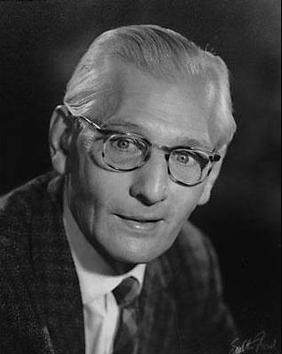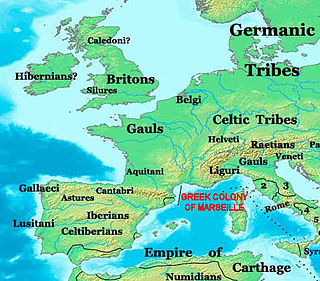Related Research Articles

The Celts or Celtic peoples were a collection of Indo-European peoples in Europe and Anatolia, identified by their use of Celtic languages and other cultural similarities. Major Celtic groups included the Gauls; the Celtiberians and Gallaeci of Iberia; the Britons, Picts, and Gaels of Britain and Ireland; the Boii; and the Galatians. The relation between ethnicity, language and culture in the Celtic world is unclear and debated; for example over the ways in which the Iron Age people of Britain and Ireland should be called Celts. In current scholarship, 'Celt' primarily refers to 'speakers of Celtic languages' rather than to a single ethnic group.

In ancient times, Armorica or Aremorica was a region of Gaul between the Seine and the Loire that includes the Brittany Peninsula, extending inland to an indeterminate point and down the Atlantic Coast.

Tasciovanus was a historical king of the Catuvellauni tribe before the Roman conquest of Britain.

The British Iron Age is a conventional name used in the archaeology of Great Britain, referring to the prehistoric and protohistoric phases of the Iron Age culture of the main island and the smaller islands, typically excluding prehistoric Ireland, which had an independent Iron Age culture of its own. The Iron Age is not an archaeological horizon of common artefacts but is rather a locally-diverse cultural phase.

The stater was an ancient coin used in various regions of Greece. The term is also used for similar coins, imitating Greek staters, minted elsewhere in ancient Europe.

Charles Francis Christopher Hawkes, FBA, FSA was an English archaeologist specialising in European prehistory. He was Professor of European Archaeology at the University of Oxford from 1946 to 1972.
Cast coinage refers to coins made by pouring melted metal into a mold, i.e. casting. It has been used for regular coins, particularly in East Asia, but also other areas on a smaller scale. The method differs from the current mode of coin production, which is done by striking coin blanks that have been cut out of metal sheets. The method has also been used by forgers.

Celtic coinage was minted by the Celts from the late 4th century BC to the mid 1st century AD. Celtic coins were influenced by trade with and the supply of mercenaries to the Greeks, and initially copied Greek designs, especially Macedonian coins from the time of Philip II of Macedon and his son, Alexander the Great. Thus Greek motifs and even letters can be found on various Celtic coins, especially those of southern France.

The Greeks in pre-Roman Gaul have a significant history of settlement, trade, cultural influence, and armed conflict in the Celtic territory of Gaul, starting from the 6th century BC during the Greek Archaic period. Following the founding of the major trading post of Massalia in 600 BC by the Phocaeans at present day Marseille, Massalians had a complex history of interaction with peoples of the region. Large Greek colonies also existed west of the Rhône, particularly at Agde and Béziers, the latter of which both predates, and was larger than, the Marseille colony.
Gilbert Kenneth Jenkins was a leading figure in 20th-century numismatics. He was the post-war generation's most important expert in the study of Greek coins and medals and would become Keeper of Coins and Medals at the British Museum in 1965.

Archaeology is promoted in Jersey by the Société Jersiaise and by Jersey Heritage. Promotion in the Bailiwick of Guernsey being undertaken by La Société Guernesiaise, Guernsey Museums, the Alderney Society with World War II work also undertaken by Festung Guernsey.
David Michael Metcalf was a British academic and numismatist. He was the director of the Heberden Coin Room of the Ashmolean Museum, a fellow of Wolfson College and Professor of Numismatics at the University of Oxford. He held the degrees of MA, DPhil and DLitt from Oxford.
Simon Bendall was an English numismatist, recognised as the leading authority on late Byzantine coins.
Sir Edward Stanley Gotch Robinson, FBA (1887–1976), usually known as SirStanley Robinson, was a numismatist specializing in Greek and Roman coins. He served as Keeper of the Department of Coins and Medals at the British Museum.

The Celtic currency of Britain were the various items and coins used as currency between approximately 200 BC and AD 60. The earliest currency consisted of various forms of iron bars. Coins were first imported in large numbers in around 150 BC and domestic minting began around 100BC. Coin production was largely ended by the Roman conquest of Britain, first by the Claudian invasion of AD 43 and later by the Defeat of Boudica in AD 60 or 61. Cast coins may have been produced for a few more years around Hengistbury Head. Exact dating of coins often changes in the light of new research.
Colin Mackennal Kraay, FBA, FSA was an English numismatist. He was the Keeper of the Heberden Coin Room at the Ashmolean Museum from 1975 to his death in 1982.

Haim Gitler is an Israeli curator and researcher, specializing in the field of numismatics. He is chief curator of archaeology and curator of numismatics at the Israel Museum, Jerusalem, as well as the President of the Israel Numismatic Society.
Esunertos, or Iisuniirtos, was a male ruler in Britain in the western Thames basin in the second half of the 1st century BC. He is known only from a few rare gold and silver coins, which provide the full spelling of his name – IISVNIIRTOS. This is also the first time that the Celtic nominative form -os- has been observed.
References
- ↑ "Philip de Jersey". Shire Books. Archived from the original on 5 May 2013. Retrieved 30 June 2012.
- ↑ De Jersey, Philip (1992). La Tène and early Gallo-Roman north-west France. E-Thesis Online Service (Ph.D). The British Library Board. Retrieved 16 November 2021.
- ↑ "The Oxford Celtic Coins Index". Portable Antiquities Scheme. Archived from the original on 29 June 2012. Retrieved 30 June 2012.
- ↑ Rudd, Chris. "50 Years of Celtic Coin Index". Coins Weekly. Retrieved 30 June 2012.
- ↑ "Heberden Coin Room: Research". Ashmolean Museum . Retrieved 30 June 2012.
- ↑ "Blunt Prize". British Numismatic Society . Retrieved 30 June 2012.